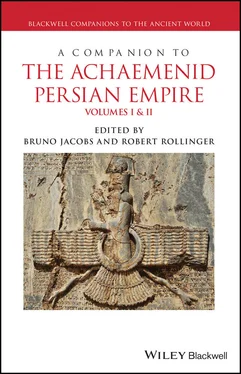3 Francfort, H.‐P. (2013). L’art oublié des lapidaires de la Bactriane aux époques achéménide et hellénistique, Persika 17. Paris: De Boccard.
4 Francfort, H.‐P., Lecomte, O. (2002). Irrigation et société en Asie centrale des origines à l’époque achéménide. Annales. Histoire, Sciences Sociales, 57 3, pp. 625–663.
5 Grenet, F. (2005). An archaeologist's approach to Avestan geography. In V.S. Curtis, S. Stewart (eds.), Birth of the Persian Empire, The Idea of Iran 1. London: I.B. Tauris, pp. 29–51.
6 Kidd, F., Betts, A.V. (2010). Entre le fleuve et la steppe: nouvelles perspectives sur le Khorezm ancien. Comptes Rendus des Seances de la Academie des Inscriptions et Belles Lettres, pp. 637–686.
7 Koshelenko, G.A. (ed.) (1985). Drevneishie gosudarstva Kavkaza i Srednei Azii [The most ancient states of the Caucasus and Central Asia]. Moscow: Nauka.
8 Lecomte, O. (2013). Activités archéologiques françaises au Turkménistan. In J. Bendezu‐Sarmiento (ed.), L’archéologie française en Asie centrale. Nouvelles recherches et enjeux socioculturels, Cahiers d’Asie Centrale 21–22, Paris, Bichkek, Kaboul: de Boccard, pp. 165–190.
9 Lo Muzio, C. (2017). Archeologia dell’Asia centrale preislamica. Dall’età del Bronzo al IX secolo d.C. Milano: Mondadori Università.
10 Lyonnet, B. (1997). Céramique et peuplement du chalcolithique à la conquête arabe, Prospections archéologiques en Bactriane orientale [1974–1978] 2; Mémoires de la Mission archéologique française en Asie centrale 8. Paris: Éditions Recherche sur les Civilisations.
11 Minardi, M. (2015). Ancient Chorasmia. A Polity between the Semi‐nomadic and Sedentary Cultural Areas of Central Asia: Cultural Interactions and Local Developments from the Sixth Century BC to the first century AD, Acta Iranica 56. Louvain: Peeters.
12 Naveh J., Shaked Sh. (eds.) (2012). Aramaic Documents from Ancient Bactria (Fourth Century BCE) from the Khalili Collection. London: The Khalili Family Trust.
13 Rapin, C. (2018). On the way to Roxane 2: satraps and hyparchs between Bactra and Zariaspa‐Maracanda. In J. Lhuillier and N. Boroffka (eds.), A Millennium of History: The Iron Age in Central Asia (2nd and 1st Millennia BC), Archäologie in Iran und Turan 16. Darmstadt: Philipp von Zabern, 2017, Paris, Bichkek, Kaboul: De Boccard, pp. 257–298.
14 Rapin, C., Isamiddinov, M. (2013). Entre sédentaires et nomades: les recherches de la Mission archéologique franco‐ouzbèke (MAFOuz) de Sogdiane sur le site de Koktepe. In J. Bendezu‐Sarmiento (ed.), L’archéologie française en Asie centrale. Nouvelles recherches et enjeux socioculturels, Cahiers d’Asie Centrale 21–22, p. 113–133.
15 Vogelsang, W.J. (1992). The Rise and Organisation of the Achaemenid Empire. The Eastern Iranian Evidence, Studies in the History of the Ancient Near East 2. Leiden/New York/Köln: E.J. Brill.
1 Briant, P. (2020). Bactria in the Achaemenid Empire. The Achaemenid Central State in Bactria (again). In R.E. Payne, R. King (eds.), The Limits of Empire in Ancient Afghanistan: Rule and Resistance in the Hindu Kush, circa 600 BCE – 600 CE. Classica et Orientalia 24, Wiesbaden: Harrassowitz, pp. 21–44. For the contacts with the Western world, with a critical discussion of the textual sources.
2 Francfort, H.‐P. (2005). Asie centrale. In P. Briant, R. Boucharlat (eds.), L’archéologie de l’empire achéménide. Paris: De Boccard, p. 313–352. An exhaustive description of the material culture of Central Asia during the Achaemenid period comprising the influences beyond the northern frontiers.
3 Francfort, H.‐P., Lecomte, O. (2002). Irrigation et société en Asie centrale des origines à l’époque achéménide. Annales. Histoire, Sciences Sociales, 573, p. 625–663. Synthesis on the economic and geographical aspect of the irrigation and human settlement in Central Asia, with important documentation relating to the Iron Age.
4 Koshelenko, G.A. (ed.) (1985). Drevneishie gosudarstva Kavkaza i Srednei Azii [The most ancient states of the Caucasus and Central Asia]. Moscow: Nauka. Soviet archeological survey of Central Asia, with an overview of the sites and their principal finds, and a rich iconographical and bibliographical documentation.
5 Rapin, C. (2018). On the way to Roxane 2: satraps and hyparchs between Bactra and Zariaspa‐Maracanda. In J. Lhuillier and N. Boroffka (eds.), A Millennium of History: The Iron Age in Central Asia (2nd and 1st millennia BC), Archäologie in Iran und Turan 16. Darmstadt: Philipp von Zabern, 2017, p. 257–298. Reconstitution of the Central Asian route of Alexander with a critical approach of the Hellenistic sources and a presentation of the geographical and political organization during the late Achaemenid period.
CHAPTER 24 The Empire's Southeast
Rémy Boucharlat
Today, the southeast of the empire covers the entire southeast of Iran (the provinces Kerman, Sistan‐Baluchistan, and Hormuzgan), the south of Afghanistan (the provinces of Kandahar and Nimruz), the western part of Pakistan until the river Indus (Baluchistan and Sind, and its northern region, ancient Gandhāra), and, very likely, part of the Arab shore of the Persian Gulf and the Arabian Sea (the United Arab Emirates, the Sultanate of Oman).
In the Achaemenid period these are the satrapies from west to east: Carmania, Drangiana, and south of the latter Makā, moreover Arachosia, India, Sattagydia, and to the north Gandhāra. But not even the borders between Fars and neighboring Carmania (Kerman) have been ascertained, due to the scarcity of information we have on the historical geography of this part of the empire. To define specific cultural horizons of each region is difficult due to the dearth of known archeological sites (Vogelsang 1992).
When looking for settlements of the Achaemenid period, the archeological research has to concentrate along ancient roads, known from Alexander's itinerary as reported by Classical authors, and in the rich valleys. Among the natural resources of that region, the Achaemenid royal inscriptions in Susa mention yakā wood from Gandhāra and ivory from India. A special green stone, chert, from Arachosia, was used for making series of mortars and pestles found in the Persepolis Treasury (Bowman 1970). The corresponding quarries have not been located yet.
Initial archeological exploration is sporadic; it begins seriously with the reconnaissances of intrepid Sir Aurel Stein in Gedrosia in 1927, then, in 1932, in Kerman down to Bandar Abbas (Stein 1931, 1937). Although he is mainly interested in prehistoric periods, he is careful to take down the late prehistoric sites that lie on his way (first millennium BCE) as well as later ones. From the great British explorations in the Indus valley and Gandhāra, information with regard to settlement in the Achaemenid epoch is sporadic. As a result, our information on the Achaemenid southeast derives from the exploration of just a few sites, barely one per region, in northern Pakistan (Akra, Charsadda, Taxila), Afghanistan (Kandahar), and Iran (Dahaneh‐i Ghulaman, Tepe Yahya, Bam, Qaleh Kutchek). This meager state of knowledge and difficulties in interpreting the results of the surveys have so far prevented a precise periodization. A map of the population and of human activities in those regions remains to be designed.
Deviant from most Near Eastern regions which were populated – almost without interruption – from the Bronze Age to the Achaemenid period, the eastern half of Iran and the south of Afghanistan seem to have been unoccupied in the second millennium BCE until the beginning of the first millennium (Azarnoush and Helwing 2005: Map 4); this gap is real, but it is also a reflection of the paucity of research. The situation is not much different in the southern Indus valley, where this period has been described as a “Dark Age” (Franke‐Vogt 2001). The resettlement is no by‐product of the Achaemenid Empire; actually, it begins before, starting in the first half of the first millennium BCE in Iron Age II or III. 1 According to a hypothesis which gains more and more approval, this fresh start was set in motion by a new irrigation technique using subterranean galleries, instead of capturing episodic run‐off and tapping springs in use since millennia. This dramatic change of technique, a response to the increasing desiccation of the climate, is well attested on the Arab shore of the Persian Gulf at about the same time, and certainly before the Achaemenid epoch (Potts 1990: pp. 391–392, 2004: pp. 78–79; Magee 2005; Wilkinson et al. 2012: pp. 167–169). A gallery like this did not lie very deep, thereby in my opinion differing from the famous qanāt , which taps a deep‐lying aquifer, probably a later technique (Boucharlat 2001, 2017).
Читать дальше












